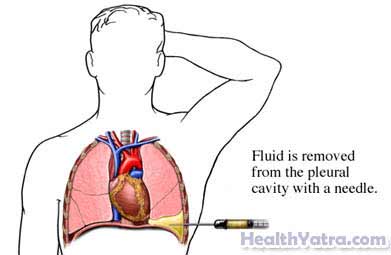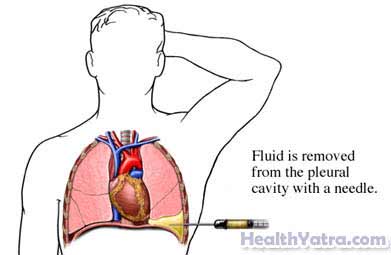Definition
A pleural effusion is a build-up of fluid in the space between the lungs and the chest wall. This space is called the pleural space. Thoracentesis is a procedure to remove fluid from this area.
There are two types of thoracentesis:
- Therapeutic thoracentesis—to relieve the symptoms of fluid accumulation
- Diagnostic thoracentesis—to test for the cause of the fluid build-up
Reasons for Procedure
There is always a small amount of fluid in the pleural space. The fluid helps to lubricate the area. When too much fluid builds up in this space, it can make it difficult to breathe.
Your doctor may want to test some of the fluid after removing it. The build-up of fluid can be a symptom of diseases or disorders, such as:
- Congestive heart failure (CHF)
- Lung infections
- Kidney disease
- Pulmonary embolism —a clot that travels to the lung
- Cancer
- Liver disease
- Pancreatitis
Smoking may increase the risk of complications.
Possible Complications
Complications are rare, but no procedure is completely free of risk. If you are planning to have a thoracentesis, your doctor will review a list of possible complications, which may include:
- A collapsed lung
- Fluid building up again
- Bleeding
- Infection
- Damage to the liver or spleen
Factors that may increase the risk of complications include:
- A history of lung surgery
- A long-term, irreversible lung disease, such as emphysema or asthma
- Anything affecting normal blood clotting
What to Expect
Prior to Procedure
Your doctor may order:
- A complete physical exam
- X-ray
- CT scan
- Ultrasound
- Blood tests
Anesthesia
A local anesthetic will be used. It will numb the area where the needle will be inserted.
Description of the Procedure
You may be asked to sit upright on the edge of a bed or chair. Your arms will be resting on a nearby table. If your procedure involves a CT scan, you may be asked to lie on a table. Try to avoid coughing, breathing deeply, or moving during the procedure.
A small patch of skin on your back, chest, or under your armpit will be sterilized. Anesthesia will be applied to this patch. It will help numb the area.
The doctor may use ultrasound or CT scan images. These images will help guide the needle and monitor the fluid. A needle or thin plastic catheter will be inserted between your ribs. The needle or catheter is then passed into the pleural space. Some or all of the fluid will be drawn into the syringe.

How Long Will It Take?
About 15 minutes
Will It Hurt?
You may feel slight pain or a stinging when the needle is first inserted. As the fluid is being extracted, you may feel a sense of pulling. Tell your doctor or nurse if you feel extreme pain, any shortness of breath, or faint.
Post-procedure Care
At the Care Center
If the thoracentesis is being done for diagnostic reasons, the fluid will be sent to a lab for testing. Often, another chest x-ray will be done to ensure that the fluid has been removed and that there is no sign of a collapsed lung.
At Home
Keep the area of skin where the needle was inserted clean and dry. To help make your recovery smooth, be sure to follow your doctor’s instructions .
If a diagnostic thoracentesis was done, ask your doctor when to expect the results.
Call Your Doctor
After arriving home, contact your doctor if any of the following occurs:
- Signs of infection, including fever and chills
- Redness, swelling, increasing pain, excessive bleeding, or any discharge from the insertion site
- Pain that you cannot control with the medicines you have been given
- Cough, shortness of breath, or chest pain
- Coughing up blood
- Pain when taking a deep breath
If you think you have an emergency, call for medical help right away.

